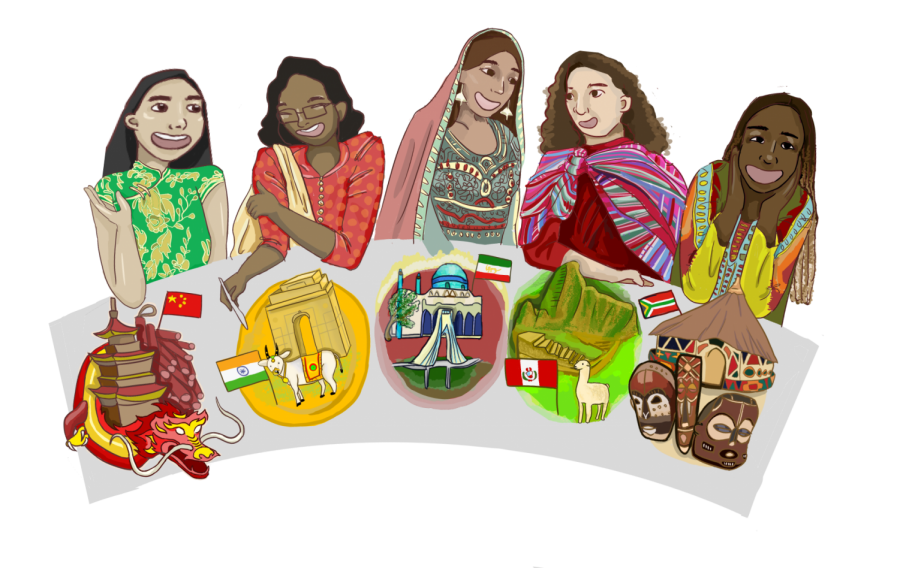Embracing our mother culture
Gloria Zhu and Arely Zhang
5 mothers sit at the table, sporting cultural garb and sitting behind plates symbolizing their native cultures. From left to right, the cultures represented are Chinese, Indian, Persian, Peruvian, and African American.
February 22, 2019
Peking duck wrapped in pancake. Shirin polo. Gulab jamun. Whether it’s crispy, sweet, fried, or cheesy, food can be found in family traditions and history of cultures all around the world.
For April Sun (9), Peking duck covered in hoisin sauce and green onion and wrapped in pancake is a tasty treat that her family enjoys together when they visit her grandparents in Beijing. They usually go to a restaurant or order takeout, and the dish brings back memories of spending time with her extended family.
During Nowruz, the first day of spring and New Year’s in Iran, Melody Yazdi (9) fondly recalls her whole family sitting down together and enjoying a dish of mahi and sabzi polo, consisting of fish and white rice with herbs. A food that holds special meaning in Persian culture is shirin polo, shirin meaning “sweet” and polo meaning “rice” in Farsi. Featuring rice covered in saffron and orange peels with a side of carrots and chicken, this dish is usually served at weddings. Another sweet Persian food is zaboon. Crispy and glazed, these puff pastries are brushed with honey before being baked. “[Zaboon’s] a really yummy sweet that they have at parties and always buy for their homes,” Melody said.
When Kimiyani Butte (10) describes gulab jamun, her eyes light up – cheese balls deep fried in syrup, this dessert is a special treat for occasions like birthdays. She remembers that for her birthday a few years ago, her mother made it to celebrate. Because this snack is not particularly healthy, it is best to be eaten on rare occasions.
Every year, Saanvi Arora (9) looks forward to Jan. 13, the day when the Indian festival of Lohri is celebrated each year. When worshipping the fire god, people walk around a bonfire and throw popcorn and nuts into the fire and eat the unburned popcorn afterward. Food also plays an important role in other Indian holidays that Saanvi’s family celebrates, like eating jelabi during Diwali.
The favorite foods of Molly Mobley (10) include mac and cheese, collard greens, gumbo catfish, and red beans served with rice and cornbread. “They’re all hearty and include ingredients that you can get from anywhere, they’re simple and tend to have a lot of flavor,” Molly said. “We have family backyard barbecues, [where we eat] a lot of steak, mac and cheese, sweet potatoes, lot of cool dishes. Usually we do potlucks, so we’ve tried a lot of different stuff.”
Wynter Chaverst (12) also loves collard greens. Typically eaten during big family meals, these greens have origins dating back to slavery in America. “Collard greens were the leftovers in the kitchen on plantations. We took the scraps we were given and turned them into a magical food that we eat with our families,” Wynter said.
When Señora Tejada talks about Peru, her smile reaches her eyes, one that shows how much she loves her culture and food. Her favorite food is ceviche, raw fish that is marinated in lime juice with garlic and salt and pepper. Being a cold dish, it is usually eaten in the summer or spring especially when family is together. “Ceviche is a very popular dish and it is a dish that we usually eat with family not because its expensive or fancy, but it’s because its very popular and most people like it. You always find ceviche during family gatherings.” Señora Tejada said.


















![“[Building nerf blasters] became this outlet of creativity for me that hasn't been matched by anything else. The process [of] making a build complete to your desire is such a painstakingly difficult process, but I've had to learn from [the skills needed from] soldering to proper painting. There's so many different options for everything, if you think about it, it exists. The best part is [that] if it doesn't exist, you can build it yourself," Ishaan Parate said.](https://harkeraquila.com/wp-content/uploads/2022/08/DSC_8149-900x604.jpg)




![“When I came into high school, I was ready to be a follower. But DECA was a game changer for me. It helped me overcome my fear of public speaking, and it's played such a major role in who I've become today. To be able to successfully lead a chapter of 150 students, an officer team and be one of the upperclassmen I once really admired is something I'm [really] proud of,” Anvitha Tummala ('21) said.](https://harkeraquila.com/wp-content/uploads/2021/07/Screen-Shot-2021-07-25-at-9.50.05-AM-900x594.png)







![“I think getting up in the morning and having a sense of purpose [is exciting]. I think without a certain amount of drive, life is kind of obsolete and mundane, and I think having that every single day is what makes each day unique and kind of makes life exciting,” Neymika Jain (12) said.](https://harkeraquila.com/wp-content/uploads/2017/06/Screen-Shot-2017-06-03-at-4.54.16-PM.png)








![“My slogan is ‘slow feet, don’t eat, and I’m hungry.’ You need to run fast to get where you are–you aren't going to get those championships if you aren't fast,” Angel Cervantes (12) said. “I want to do well in school on my tests and in track and win championships for my team. I live by that, [and] I can do that anywhere: in the classroom or on the field.”](https://harkeraquila.com/wp-content/uploads/2018/06/DSC5146-900x601.jpg)
![“[Volleyball has] taught me how to fall correctly, and another thing it taught is that you don’t have to be the best at something to be good at it. If you just hit the ball in a smart way, then it still scores points and you’re good at it. You could be a background player and still make a much bigger impact on the team than you would think,” Anya Gert (’20) said.](https://harkeraquila.com/wp-content/uploads/2020/06/AnnaGert_JinTuan_HoHPhotoEdited-600x900.jpeg)

![“I'm not nearly there yet, but [my confidence has] definitely been getting better since I was pretty shy and timid coming into Harker my freshman year. I know that there's a lot of people that are really confident in what they do, and I really admire them. Everyone's so driven and that has really pushed me to kind of try to find my own place in high school and be more confident,” Alyssa Huang (’20) said.](https://harkeraquila.com/wp-content/uploads/2020/06/AlyssaHuang_EmilyChen_HoHPhoto-900x749.jpeg)









